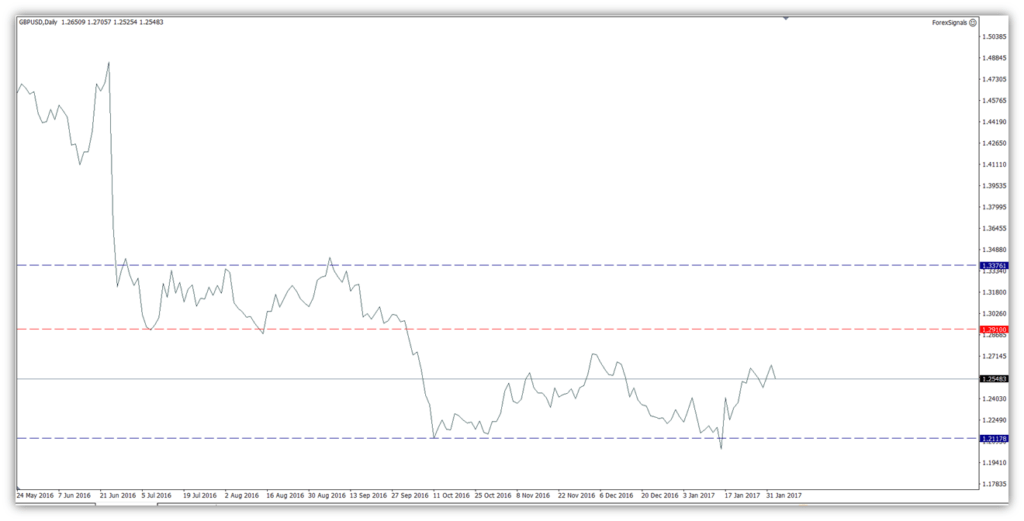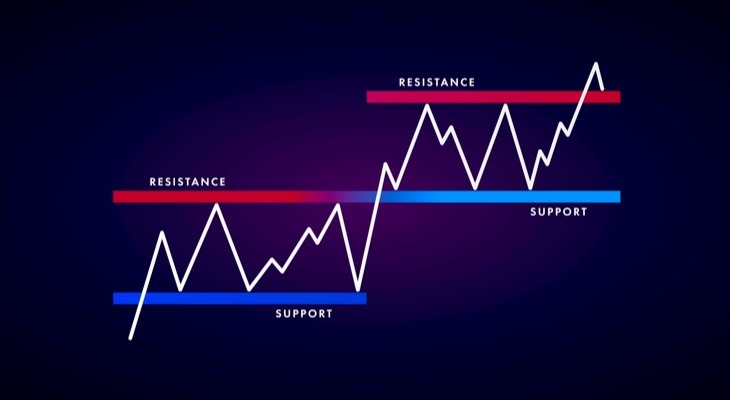Several technical analysis indicators are available, including the Moving Average (MA) Bollinger Bands, Relative Strength Index, and many more. But one of the best tools for properly determining a trading strategy’s entry and exit points is sketching a chart’s support and resistance levels.
Therefore, for those unfamiliar, here is a brief overview of support and resistance levels and how to locate them on a chart for those of you.
What Are Levels of Support and Resistance?
Let’s start by taking a look at a solid illustration of a clearly defined level of resistance on the GBPUSD chart:

This is the most current chart for the GBPUSD pair as of the time of this article. This level, around 1.29 to 1.29100 (also known as the “dog zone”), will be known to every “Tom, Dick, and Harry” on the planet.
Suppose a price action level has previously been tested or, as in the case of the example above, is currently approaching to “check” previous support. In that case, a day trader will refer to that level as resistance. I like the GBPUSD example above; the price rotates back up to this price level at 1.29–1.291, then this may be regarded as the first touch of the resistance zones.
The price is bullish into the story and the previous primary support, marked in the blue box. Again, as we’ve seen indicated in the blue box, if the price were bearish into a level of comparable magnitude like this, we’d refer to it as a support level.
Any financial market must have support and resistance levels. They are levels when supply and demand (also known as order flow), determined by market participants (you and I), quickly change. The bulls and bears clash at this stage, and overall, the winning side takes the battle. It’s pricing when buyers or sellers yield to their counterparties, nearly to the point where the market is submissive or reactive.
Therefore, knowledgeable traders often use support and resistance levels as a trading technique in a range-bound market, which entails always buying the asset when the price hits the horizontal support level and selling the asset when the price approaches the resistance level. The twist, though, is that you can anticipate a shift in price action—an upward or negative trend in the market—once the price tests these psychological levels and finally breaks above or below the support and resistance price levels. You should then be trading the trend if the price moves above support and resistance.
Why Are Levels of Support and Resistance Useful in Trading?
Knowing that the range of 1.29 to 1.291 served as significant support in the previous example on the GBPUSD, we can build “traps” in the expectation that if the GBPUSD returns to this level, we will be prepared to respond. Put another way; we want to be aware of significant potential turning moments to reduce the risk and maximize our profit. R multiples are what I’m talking to here in trading, but that’s a topic for another essay.
We can identify support and resistance levels and determine the best place to enter the market if we can highlight a significant level of support or resistance. We need to be mindful of a few criteria when determining whether a level is essential or not since this is a discretionary procedure. It is because, although this is not a precise science, we can still recognize some basic logic.
How to determine levels of support and resistance?
I’ll provide the general guidelines and essential ideas for determining support and resistance levels based on my observations over ten years in the forex market:
- Price doesn’t fluctuate wildly. They are “ranges” or “zones,” not definite levels.
- The longer the period, the more trustworthy (a weekly chart is recommended).
- A level’s likelihood of breaking increases with the times it is quickly “checked.”
- Distance makes the heart grow fonder; if a price repels from a significant level for an extended time, that level becomes more meaningful to penetrate on the first return.
- Spacing between each peak and dip is crucial.
- Consider each bar’s closing price more while assessing a level.
- At periods of the day when there is greater liquidity, support and resistance levels are more likely to break.
- Whole numbers, like 1.2300 and 1.2000, are more interesting (Carol Osler PhD wrote an engaging publication on the Forex market microstructure). A round number could be used as a take profit or stop loss.
- Excellent trading opportunities exist at resistance and support levels in range markets.
Looking at the “line graph” on the MetaTrader 4 trading platform might make locating these levels simpler for you. It will display each bar’s whole near pricing range. After that, all you need to do is learn how to add horizontal lines to a chart in various time frames and spot levels of support and resistance. Similarly, many traders feel that utilizing Fibonacci retracement levels to identify support and resistance levels is a valuable technique. If this indicator is new to you, Fibonacci levels are set to support, and resistance levels run in a particular order from lowest to highest (Fibonacci sequence: 23.6 percent, 38.2 percent, 61.8 percent, and 78.6 percent).

Once again, here is the same GBPUSD chart’s daily period. You can see that although I am approximately adhering to the aforementioned broad characteristics, I am not searching for ideal levels where the price has abruptly changed direction.
Establish a system for identifying pronounced and distinct degrees of support and opposition. This technical analysis tool helps you identify “hurdles” or price levels where the price may be struggling, but it also teaches you how to be ready to trade these levels when and if the price revisits them, which helps you make smarter trading choices. It is a classic trading method, especially for individuals who often use predetermined chart patterns. You now need to add horizontal lines to your trading platform and methodologically learn how to detect support and resistance levels.
Planning and preparation are essential components of trading, mainly day trading. If you don’t plan, you’ll fail.
You can also go through this post if you want to learn about hedging.

